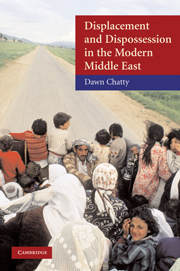Book contents
- Frontmatter
- Contents
- List of Tables
- List of Charts and Maps
- Acknowledgements
- Introduction: Dispossession and Forced Migration in the Middle East: Community Cohesion in Impermanent Landscapes
- 1 Dispossession and Displacement within the Contemporary Middle East: An Overview of Theories and Concepts
- 2 Dispossession and Forced Migration in the Late Ottoman Empire: Distinct Cultures and Separated Communities
- 3 Circassian, Chechnyan, and Other Muslim Communities Expelled from the Caucasus and the Balkans
- 4 The Armenians and Other Christians: Expulsions and Massacres
- 5 Palestinian Dispossession and Exodus
- 6 Kurds: Dispossessed and Made Stateless
- 7 Liminality and Belonging: Social Cohesion in Impermanent Landscapes
- Bibliography
- Index
2 - Dispossession and Forced Migration in the Late Ottoman Empire: Distinct Cultures and Separated Communities
Published online by Cambridge University Press: 05 June 2012
- Frontmatter
- Contents
- List of Tables
- List of Charts and Maps
- Acknowledgements
- Introduction: Dispossession and Forced Migration in the Middle East: Community Cohesion in Impermanent Landscapes
- 1 Dispossession and Displacement within the Contemporary Middle East: An Overview of Theories and Concepts
- 2 Dispossession and Forced Migration in the Late Ottoman Empire: Distinct Cultures and Separated Communities
- 3 Circassian, Chechnyan, and Other Muslim Communities Expelled from the Caucasus and the Balkans
- 4 The Armenians and Other Christians: Expulsions and Massacres
- 5 Palestinian Dispossession and Exodus
- 6 Kurds: Dispossessed and Made Stateless
- 7 Liminality and Belonging: Social Cohesion in Impermanent Landscapes
- Bibliography
- Index
Summary
The fall of the Ottoman, Habsburg and Russian empires … generated about thirty new states…. One can reasonably place Ottomans, Habsburgs, and Romanovs into the same pigeon-hole; all were obsolescent political entities in an era of nation-building, to which they offered no alternative. All were weak (relative to their official size and resources) and therefore endangered players in the international power game. All were regarded as doomed, or at least as on the slide, for many decades before they actually fell.
(Hobsbawm 1997:13)The sentiment expressed in the Hobsbawm quote, which places the end of the Ottoman Empire in the same ‘pigeon-hole’ as the Habsburgs' Austro-Hungarian Empire and the Romanovs' Russian Empire, broadly outlines the generally accepted features of the terminal decline of these states. The ending of these empires at the beginning of the twentieth century was marked by the distinct disruption of state structures. Single states were divided into several, and each of these non-national, multi-ethnic entities had to be transformed into a number of notionally national but often, in fact, still multi-ethnic states. More important, the ‘End of Empire’ broke what had been a coherent web of internal relations within the single states, into unintelligible fragments. It automatically set people onto forced journeys of migration seeking others with whom they might take refuge and so mass movements of mainly ethno-religious communities defined the moment.
- Type
- Chapter
- Information
- Displacement and Dispossession in the Modern Middle East , pp. 38 - 90Publisher: Cambridge University PressPrint publication year: 2010



